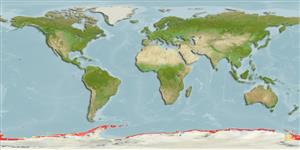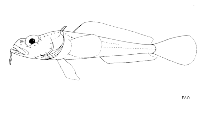Pogonophryne permitini Andriashev, 1967
Finespotted plunderfish
Добавить Ваши наблюдения в Fish Watcher
| Native range | All suitable habitat | Point map | Year 2050 |

|
| This map was computer-generated and has not yet been reviewed. |
| Pogonophryne permitini AquaMaps Data sources: GBIF OBIS |
Загрузить свой Фото и Видео
Pictures | Изображение на GooglePogonophryne permitini
Picture by FAO
Pictures | Изображение на GooglePogonophryne permitini
Picture by FAO
Common names from other countries
Классификация / Names народные названия | синонимы | Catalog of Fishes(род, виды) | ITIS | CoL | WoRMS | Cloffa
> Perciformes/Notothenioidei (Icefishes) > Artedidraconidae (Barbled plunderfishes)
Etymology: Pogonophryne: Greek, pogon = beard + Greek, phrynos = toad (Ref. 45335).
Eponymy: Dr Yuri Efimovich Permitin (d: 1925) was a Russian ichthyologist and marine fisheries scientist. [...] (Ref. 128868), visit book page.
More on author: Andriashev.
Etymology: Pogonophryne: Greek, pogon = beard + Greek, phrynos = toad (Ref. 45335).
Eponymy: Dr Yuri Efimovich Permitin (d: 1925) was a Russian ichthyologist and marine fisheries scientist. [...] (Ref. 128868), visit book page.
More on author: Andriashev.
Environment: milieu / climate zone / depth range / distribution range экология
морской батидемерсальный; пределы глубины 430 - 1120 m. Deep-water; 60°S - 78°S
распространение страны | регионы FAO | Ecosystems | места находок | Point map | интродукции | Faunafri
Southern Ocean: east Antarctica (Davis Sea, Ross Sea, Weddell Sea), South Shetland Islands and South Orkney Islands.
Size / Вес / Возраст
Feeds on isopods, gammaridean amphipods, octopods, polychaetes and mysids.
Life cycle and mating behavior половая зрелость | размножение | нерест | икра | Fecundity | личинки
Основная ссылка
Upload your references | ссылки | координатор | соавторы
Eakin, R.R., 1990. Artedidraconidae. p. 332-356. In O. Gon and P.C. Heemstra (eds.) Fishes of the Southern Ocean. J.L.B. Smith Institute of Ichthyology, Grahamstown, South Africa. (Ref. 5181)
Угроза для людей
Harmless
Использование человеком
рыболовство: интереса не представляет
FAO(рыболовство: production; publication : search) | FishSource | Sea Around Us
дополнительная информация
Population dynamics
Growth parameters
Max. ages / sizes
Length-weight rel.
Length-length rel.
Размерный состав
Mass conversion
пополнение
численность
Growth parameters
Max. ages / sizes
Length-weight rel.
Length-length rel.
Размерный состав
Mass conversion
пополнение
численность
Life cycle
размножение
половая зрелость
Fecundity
нерест
Spawning aggregations
икра
Развитие икры
личинки
динамика численности личинок
размножение
половая зрелость
Fecundity
нерест
Spawning aggregations
икра
Развитие икры
личинки
динамика численности личинок
Anatomy
жаберная область
Brain
Otolith
жаберная область
Brain
Otolith
Physiology
Body composition
Nutrients
Oxygen consumption
Swimming type
Swimming speed
Visual pigments
Fish sound
Diseases & Parasites
Toxicity (LC50s)
Body composition
Nutrients
Oxygen consumption
Swimming type
Swimming speed
Visual pigments
Fish sound
Diseases & Parasites
Toxicity (LC50s)
Genetics
генетика
Heterozygosity
наследуемость
генетика
Heterozygosity
наследуемость
Human related
Aquaculture systems
особенности рыбоводства
степень растяжения
Ciguatera cases
Stamps, coins, misc.
Aquaculture systems
особенности рыбоводства
степень растяжения
Ciguatera cases
Stamps, coins, misc.
инструменты
E-book | полевой определитель | Длина-Частота | онтогенез | карта точек | Classification Tree
| Catch-MSY |
Специальные отчеты
Проверить содержание в аквариумах | Проверить опубликованные видовые данные | Проверить опубликованные данные по аквакультуре
Скачать в формате XML
ресурсы в Интернет
Aquatic Commons | BHL | Cloffa | Websites from users | Проверить FishWatcher | CISTI | Catalog of Fishes(род, виды) | DiscoverLife | ECOTOX | Faunafri | Fishtrace | GenBank(Геном, Нуклеотид) | GloBI | GOBASE | | Google Books | Google Scholar | Google | IGFA World Record | MitoFish | Otolith Atlas of Taiwan Fishes | PubMed | Reef Life Survey | Scirus | SeaLifeBase | Tree of Life | Wikipedia(Вперёд, поиск) | World Records Freshwater Fishing | Zoobank | Zoological Record
Estimates based on models
Preferred temperature (Ref. 115969): -1.6 - 1, mean 0.3 (based on 415 cells).
Phylogenetic diversity index (Ref. 82804): PD50 = 0.5000 [Uniqueness, from 0.5 = low to 2.0 = high].
Bayesian length-weight: a=0.00661 (0.00381 - 0.01146), b=3.16 (3.00 - 3.32), in cm Total Length, based on LWR estimates for this species & (Sub)family-body (Ref. 93245).
Trophic level (Ref. 69278): 3.3 ±0.46 se; based on food items.
Fishing Vulnerability (Ref. 59153): Low vulnerability (11 of 100).
Climate Vulnerability (Ref. 125649): Moderate to high vulnerability (50 of 100).




